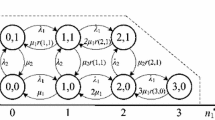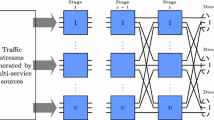Abstract
In this paper, we investigate a multi-rate network in which wide-band calls are allowed to wait if insufficient resources are available at the time of the call arrival. On the link level, an analytical model is presented and simulations have been carried out on the network level. The results indicate that allowing a few wide-band calls to queue can give a significant improvement in performance in terms of network revenue , as well as a means to level out the blocking probabilities of the different traffic classes. This improvement becomes significant when the service discipline of the waiting calls (of different bandwidth requirements) is adaptive in the sense that longer queues get served first. This observation motivates the investigation of the impact of various buffer space assignment and queueing disciplines on network revenue and call blocking probabilities. The study of such mixed delay and queueing networks is motivated by its possible applications to traffic problems in future Broadband Integrated Services Digital Networks as well as in multi-rate cellular radio networks.
Similar content being viewed by others
References
Cost 242 Interrim Report, M. Ritter, P. Tran-Gia (ed.), Multi-Rate Models for Dimensioning and Performance Evaluation of ATM Networks, Commission of the European Communities, 1994.
J.W. Roberts (ed.), “Performance Evaluation and Design of Multiservice Networks”, Published by the Commission of the European Communities, Information Technologies and Sciences, COST 224 Final Report, ISBN 92-826-3728-X, 1991.
C-P. Chung and K.W. Ross, “Reduced Load Approximations for Multi-Rate Loss Networks”, ACM/IEEE Trans. on Networking, pp. 1222–1231, 1993.
D. Calin, D. Zeghlache, G. Pujolle, “Traffic Model of a Mixed Media Cellular System”, 5th International Conference on Telecommunication Systems, IFIP, Nashville, 1997.
L.A. Gimpelson, “Analysis of Mixtures of Wide-and Narrow-Band Traffic”, IEEE Trans. on Commun. Technol., pp. 258–266, 1965.
Winfried K. Grassmann, Michael I. Taksar and Daniel P. Heyman, “Regenerative Analysis and Steady State Distributions for Markov Chains”, Operations Research, Vol. 33, No.5, pp. 1107–1116, 1985.
R. Guérin, “Queueing Blocking System with Two Arrival Streams and Guard Channels”, IEEE Trans. on Comm., pp. 153–163, 1988.
R. Guérin, H. Ahmadi and M. Naghshineh, “Equivalent Capacity and Its Application to Bandwidth Allocation in High Speed Networks”, IEEE Journal on Selected Areas in Communications, 1991.
Daniel P. Heyman, “Further Comparisons of Direct Methods for Computing Stationary Distributions of Markov Chains”, SIAM J. Alg. Disc. Math., Vol. 8, No.2, pp. 226–232, 1987.
J.Y. Hui, “Resource Allocation for Broadband Networks”, IEEE J-SAC, Vol. SAC-6, pp. 1598–1608, 1988.
F.P. Kelly, “Routing in Circuit Switched Networks: Optimization, Shadow Prices and Decentralization”, Adv. Appl Prob., 1988.
D.K. Kin and C.K. Un, “Performance Analysis of Bandwidth Allocation Strategy with State-Dependent Bernoulli Access and Preemptive Priority in Wideband Integrated Networks”, Telecommunications Systems, Vol. 4, pp. 97–111, 1995.
Colm Art O'Cinneide, “Entrywise Perturbation Theory and Error Analysis for Markov Chains”, Numer. Math., Vol. 65, pp. 109–120, 1993.
K.W. Ross, “Multiservice Loss Models for Broadband Telecommunication Networks”, Springer Verlag, ISBN 3-540-19918-7, 1995.
Y.D. Serres and L.G. Mason, “A Multiserver Queue with Narrow-and Wide-Band Customers and Wide-Band Restricted Access”, IEEE Trans. on Comm., Vol. 36, pp. 675–684, 1988.
E.D. Sykas, K.M. Vlakos, I.S. Venieris and E.N. Protonotarios, “Simulative Analysis of Optimal Resource Allocation and Routing in IBCN's”, IEEE J-SAC, Vol. 9, No.3, 1991.
G. Choudhury, K.K. Leung and W. Whitt, “Efficiently Providing Multiple Grade of Service with Protection Against Overloads in Shared Resources”, AT&T Technical Journal, pp. 50–63, 1995.
Author information
Authors and Affiliations
Rights and permissions
About this article
Cite this article
Fodor, G., Blaabjerg, S. & Andersen, A.T. Modeling and Simulation of Mixed Queueing and Loss Systems. Wireless Personal Communications 8, 253–276 (1998). https://doi.org/10.1023/A:1008899503856
Issue Date:
DOI: https://doi.org/10.1023/A:1008899503856




